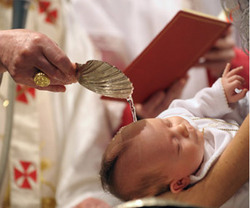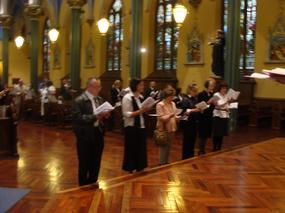A substantial part of the Pope’s Sunday Angelus address is worth thinking about: the reality of Baptism. Why? Because I think many of us have yet to grasp some of the essential points of what the Catholic Church believes and teaches. What I notice, as you may have, that even the clergy have a faulty understanding of what the sacrament of Baptism is meant to do for the person. It is not a social event for the family. It is not an opportunity to quiet the screams of family members (grandma) regarding “the way it is done in this family”, etc. Baptism is about a life in Christ. Period.
BUT what is the sacrament of Baptism all about? At the time of baptizing children or baptizing adults we are given a supreme gift by God: love. Let me briefly explain what baptism is and what it gives to us. These points don’t exhaust the teaching and the conversation of what happens when one is baptized:
A. there’s a forgiveness of sins –the baptized person “dies to sin” (Romans 6); for the adult person there is repentance and deliberate renunciation of personal sin, AKA, conversion;
B. there’s a configuration to Christ, that is, a person comes to a close union with Jesus: baptism unties the Christian with Christ–it is a union of mind and will; the person is made new; the the baptized person is a sharer in Christ’s own paschal mystery (life, death, resurrection and ascension, Romans 6:1-11); the soul is changed permanently, which we call sacramental character;

C. the baptized person is given the gift of the Holy Spirit–he or she is “re-generated” in the Holy Spirit (1 Cor. 12:13); the gift of the Holy Spirit is personally present and dwelling in each person; the Holy Spirit gives eache person the grace of becoming sons and daughters of God the Father, also the Spirit gives each person the power to say, “Abba, Father” (Romans 8:15; Galatians 4:6): St Paul is clear, by the Holy Spirit we can utter the holy name, Jesus Christ and call Him “Lord”;
D. as baptized persons we have a new relationship with God the Father as adopted children of God; this new relationship speaks of our destiny–God wants us to be saved–He offers each person salvation through Jesus Christ AND His Church;
E. baptism gives each person membership in the Church, not like a membership at a gym or a country club or Sam’s Club; we are brought into, incorporated in the Church as a communion of faith and a communion of saints; in the Church we receive grace AND we work out our salvation through the worshipping community and together as a community in mission to realize the Gospel.
And now the Pope’s address:
The Baptism of the Lord [the feast celebrated this past Sunday, Jan 10] suggests quite well the general sense of the Christmas festivity in which the theme of “becoming sons of God” thanks to the only-begotten Son’s taking on of our humanity constitutes a dominant element. He became man so that we could become sons of God. God is born so that we could be re-born.
 Many of the religious orders have what is called a Third Order Laity, or some such name for the laity who are closely connected spiritually and morally to an Order and continue to live their lives according to the vocation they’ve been given: the single life, married life or secular priesthood.
Many of the religious orders have what is called a Third Order Laity, or some such name for the laity who are closely connected spiritually and morally to an Order and continue to live their lives according to the vocation they’ve been given: the single life, married life or secular priesthood.